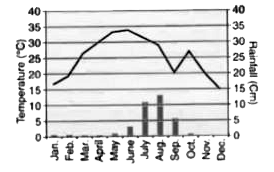Complete Solutions to HIGHER ORDER THINKING QUESTIONS of chapter INDIA -A SUBCONTINENT of Class 10 book with complete answers and questions
| Class 10 | GEOGRAPHY |
| Chapter | INDIA -A SUBCONTINENT |
| MCGROW HILL PUBLICATION | HIGHER ORDER THINKING QUESTIONS |
| Number Of Questions | 20 |
| Academic Year | 2023-24 |
Which of the following countries does not share its boundaries with India?
View SolutionThe Eastern most longitude of India is
View SolutionA major line of latitude that passes through Mizoram also passes through which one of the following states?
View SolutionObserve the following graph of a particular place. It is situated at an altitude of 224 meters above Mean Sea Level and at latitude `26^@18'`N

Identify the type of natural vegetation most likely to be found in this placeView SolutionNational Highway-7 is the longest national highway in India, which traverses between Varanasi and Kanya Kumari. Identify the places en route from North to South.
View SolutionGiven below are two statements, one labeled as Assertion (A) and the other labeled as Reason (R)
Assertion (A): In India, the east coast has more seaports than the west coast.
Reason (R): The east coast is broader and is an example of emergent coast. Select the correct option from the given alternatives.View SolutionWhich four major ports of India lie on the Golden Quadrilateral?
View SolutionBoth the latitudinal and longitudinal extent of India's mainland is about `30^@`. But on looking at the map of India which of the following al ternatives do you observe about India's size?
View SolutionWhich of the following parallels of latitude divides India into two almost equal parts?
View SolutionIndia achieved multi-faceted socio-economic progress during which of the following periods?
View SolutionWhich of the following is the oldest route of contact between India and other countries of the world?
View SolutionDue to which of the following reasons is the Indian Ocean named after India?
View SolutionWhat is the position of India in the world in respect of area?
View SolutionGeologically, which of the following physiographic divisions of India is supposed to be one of the most stable land blocks?
View SolutionWhich of the following is responsible for the variation in the colour of soil in different parts of India?
View SolutionWhich of the following has not been a factor in the creation and modification of India's relief features?
View SolutionWhich of the following is a plausible theory presented by Earth scientists to explain the formation of continents and oceans and the various landforms?
View SolutionAccording to the “Theory of Plate Tectonics,' when some plates come towards each other, which of the following is formed?
View SolutionWhich of the following divisions of India has the oldest landmass?
View SolutionThe northward drift of the Indo-Australian plate resulted in its collision with the much larger Eurasian plate. Which of the following was the result of this collision?
View Solution
HIGHER ORDER THINKING QUESTIONS questions and complete solutions for chapter INDIA -A SUBCONTINENT of MCGROW HILL EDUCATION GEOGRAPHY (HINGLISH) of Class 10
